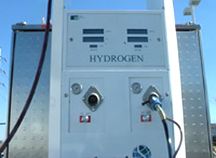Filling up the family car with gasoline, we take some things for granted. The official labels that reveal the octane rating of the gas, inspection stickers, the location of the pumps relative to streets, buildings, tanks. Unseen codes and standards envelop the filling station to provide customers with an administrative layer of safety most of us rarely consider.

For the hydrogen station of the future, similar codes and standards are being developed today, and Sandia is playing a key role.
Within DOE, these standards are one of several elements of the hydrogen economy being addressed by the national laboratories system, says Chris Moen, manager of Sandia/California’s Thermal/Fluid Science and Engineering Dept. 8757.
“In the safety, codes, and standards program element there is a harmonization element and R&D part. We are responsible for the R&D part, which I think is the fun stuff,” says Chris.
Within the complex, the National Renewable Energy Lab is addressing domestic safety standards, and Los Alamos is working on international standards. “These areas require a lot of consensus building,” says Chris. “At Sandia, we are trying to provide technical information to support the codes and standards organizations.”
Ultimately the goal is to have a set of acceptable domestic standards that are harmonized with international standards as much as possible.
Sandia is addressing the science and technology that goes into understanding unintended releases of hydrogen in the cases of large high-pressure (momentum-driven) or small (buoyancy-dominated) releases. The Labs also have an eye on the development of sensors for leak detection and other mitigation strategies. This year, Sandia will pursue codes and standards research with a budget of about $1.5 million.
“We are trying to work with the people who are writing the codes and standards so they have good information,” says Chris. Some industrial standards already exist for hydrogen. “If you want to build a refinery, there are codes and standards that tell you how far to situate a tank from other buildings and things like that,” says Chris. But there are no agreed-upon standards and codes for general public interaction with hydrogen on a daily basis, as will be likely in the envisioned hydrogen economy of the future.
Multiple stakeholders
Stakeholders for Sandia’s research are code and standards development organizations, which are working to write technically sound code. Other stakeholders are original equipment manufacturers (OEMs) and the energy companies, which tend to look at the standards as enabling product commercialization. Within DOE’s FreedomCAR and Fuels initiative — to develop pollution- and petroleum-free vehicles — technical teams have been established with industry advisors. “Everything we do gets scrutinized by the OEMs and energy companies, so that we get good feedback about what’s important to them,” says Chris.
Sandia researchers started in 2003 with studies of unintended releases of momentum-driven gas, or jet-type releases. Experiments at 2,500 and 6,000 psi at the SRI burn site east of Livermore, Calif., were conducted under contract to measure the jet characteristics. “One of high-priority items for us was what separation distances are needed for siting equipment at refueling stations,” says Chris. “There was a lack of information for hydrogen in jets, where there may be a fire hazard.”
Small-scale experiments
Sandia worked with the International Code Council as experiments were conducted. Labs researchers also talked to the National Fire Protection Association and presented the data to it.
The next effort involves a transition to small-scale releases, like hairline cracks, O-rings, fittings, and fixtures. These leaks create gases that are not momentum-dominated but buoyant, says Chris. Sandia will do these experiments at the Combustion Research Facility (CRF), with Bob Schefer (8367) as principal investigator. Bill Houf (8757) will generate engineering models based on the data. The engineering models are used to rapidly quantify the consequences of unintended releases.
Sandia is also contributing to future standards by analyzing how metallic materials interact with hydrogen. Generally, molecular hydrogen dissociates on a metal surface and diffuses into the material, affecting the properties. Often, these effects include making metal more brittle and reducing its strength.
Sandia has created a technical reference on these compatibility issues based on the Labs’ 40 years of experience in storing hydrogen in metal containers. The reference also uses other peer-reviewed published literature. Staff metallurgists Brian Somerday and Chris San Marchi (both 8772) are writing the reference guide. They are describing compatibility issues for various grades of steel and other materials in a web document, http://www.ca.sandia.gov/matlsTechRef, available to groups writing the codes involving structural design for hydrogen use. “Everything we learned about hydrogen compatibility in Defense Programs can apply to this project,” says Chris.
Sandia has worked with the American Society of Mechanical Engineers to develop codes for pressure vessels for different material classes and effects, as well as with CSA. “We want to understand how hydrogen works with other materials,” says Chris.
Unique equipment
Sandia can do even more, given the opportunity. One area where the Labs can contribute is in materials testing where no information currently exists. Pressures of 10,000 to 15,000 psi are expected in hydrogen refueling; this means pressurized atomic hydrogen will be reacting with the container metals. “We have some unique equipment here we are using in Defense Programs that we also use to develop data for the codes and standards project,” says Chris. “We can test static crack growth at pressures up to 30,000 psi to understand some of these interactions.” Testing at pressure and with cyclic loads is another option Sandia researchers could explore.